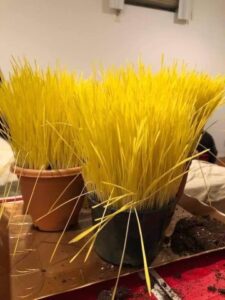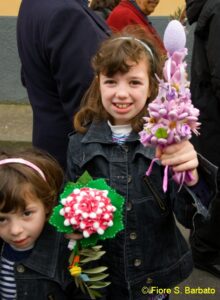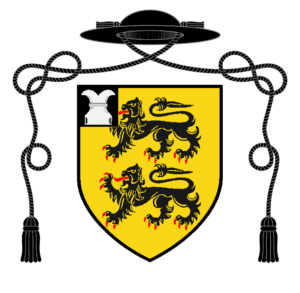Some Holy Week Traditions of Italy
by Fr. William Rock, FSSP

As impressive and imposing as the historical ceremonies of Holy Week are, there grew up around them, and with them, from the well-formed piety of the faithful, other practices which, while complementing these liturgies, give them a more local flavor. In this way, place is found for both the universality of the Catholic Liturgy and also local customs. With this background, I would like to share here some Holy Week traditions from Italy.
The first actually begins at the start of Lent. In southern Italy, wheat is planted in shallow pots and then kept in a warm room with no light. Because of these conditions, the wheat grows with a golden color, instead of the usual green. In modern times, sometimes these pots also have flowers planted in them. On Holy Thursday, these pots, called sepolcri (lavureddi in Sicilian) are used to decorate the Altar of Repose. After the conclusion of the ceremonies, the golden wheat is planted in fields as a blessing.1

Also on Holy Thursday, in certain villages, those men who had their feet washed would receive a bread wreath. In some places, such as in Calabria, dough shaped to represent the instruments of the Passion were baked onto the wreaths.
On Palm Sunday, olive branches are blessed in lieu of or together with palms. Prior to the reform of Holy Week under Pope Pius XII, the first of the five blessings was particularly for these branches.2 The text of this first prayer is as follows:
We beseech thee, O holy Lord, almighty Father, eternal God, that thou wouldst be pleased to bless and sanctify this creature of the olive tree, which thou madest to shoot out of the substance of the wood, and which the dove, returning to the ark, brought in its bill; that whoever receiveth it, may find protection of soul and body, and that it may prove, O Lord, a saving remedy, and a sacred sign of thy grace. Through, &c.3
The second, third (which says that “the olive branches proclaim, in some manner, the coming of a spiritual unction”4), and fifth prayers refer to both palm and olive branches. The focus of the fourth prayer is the olive branch, although the branches of other trees are mentioned:
O God, who by an olive branch didst command the dove to proclaim peace to the world; sanctify, we beseech thee, by thy heavenly benediction, these branches of olives and other trees; that they may be serviceable to all thy people unto salvation. Through, &c.5

In the same spirit of this prayer, again in certain villages, if there were any major disputes (such as siblings not speaking to each other) one of the parties could take one of these blessed olive branches after Mass and go the house of the other party. He would then offer the olive branch as way of signifying his desire for peace. If the branch was accepted, peace was established between them, and the dispute was never to be mentioned again. This was a public proposition of peace and reconciliation, similar to that done by Byzantine Christians at the start of Lent, but here a literal olive branch is extended. The hope was that peace could be restored before the Easter Season.
There is also a particular tradition common to the region of Campania, where the olive branches are decorated, including with treats. These olive branches are typically given as gifts to family and friends.

This tradition is particularly strong in the town of Sorrento, on the bay of Naples. In this town they adorn the olive branches with caciocavallo cheese, little salamis, and colored ribbons. There is also the particular tradition of making palme di confetti, artificial twigs or saplings, and also baskets, decorated with treats called confetti or Jordan almonds, which are sugar-covered almonds. According to pious tradition, in the sixteenth century, the town was threatened by a Saracen fleet on one Palm Sunday. The faithful had taken refuge in the cathedral church and prayed for deliverance. The priest, already vested for the ceremony, proceeded with the blessing of olive branches. The second blessing from the Missal of Pius V, it should be noted, asks that where these blessed branches are that God’s “right hand may preserve from all adversity and protect those that have been redeemed by our Lord Jesus Christ thy Son.”6 Perhaps this prayer was in use at this time in Sorrento. In any case, during the blessing, in response to their prayers and possibly also due to the power of the sacramentals recently blessed, a storm broke out and the ships were sunk. There was, according to the account, only one survivor, a young slave girl. She made it to shore and, in thanks to God for saving her both from death and slavery, embraced the Catholic Faith. She was found by a fisherman and led to the cathedral where she was welcomed by the townsfolk. In gratitude, she offered the confetti she was carrying on her which were distributed among those gathered. Until this time, the confection was unknown in the area. With the memory of this event, these artificial palme di confetti are made and blessed on Palm Sunday together with natural olive branches.7
As was said at the beginning of this article, practices such as these complement the universal Liturgy, allowing for local expression. May these practices, formed under the wings of the Liturgy, as it were, by our Catholic forefathers, be restored where they have fallen into neglect, preserved where they are still practiced, and adopted/adapted where proper. For they are also treasures of the Church.
Fr. William Rock, FSSP was ordained in the fall of 2019 and is currently assigned to Regina Caeli Parish in Houston, TX. Thanks are owed to Mr. Patrick A. O’Boyle, Esq., SMOCG, for his contributions.
In support of the causes of Blessed Maria Cristina, Queen, and Servant of God Francesco II, King
-
- The Italian Apostolate of the Archdiocese of Newark is reviving this practice.
- In the Holy Week promulgated by Pope Pius XII, only one prayer, which was previously the fifth, is used for the blessing of the palms and possibly the branches of olive and other trees, depending.
- Guéranger, Prosper. The Liturgical Year, vol. 6 (Passiontide and Holy Week). Trans. Shepherd, Laurence. (Fitzwilliam: Loreto Publications, 2000), p. 208.
- Ibid., p. 209.
- Ibid., p. 210.
- Ibid., p. 209.
- More information can be found on articles online here, here, here, here, and here.
March 24, 2024









